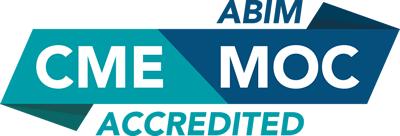
COURSE CREDITS & HOURS
14 AMA PRA Category 1 Credits™14 ACPE Credits
14.0 Contact Hours
14 (part II) MOC points in medical knowledge in the American Board of Internal Medicine's (ABIM) Maintenance of Certification (MOC) program
COURSE FEES
TARGET AUDIENCE
PROGRAM PURPOSE
- Litigation Stress
- Discuss the typical physical and emotional reactions
- Learn to develop support systems and utilize privileged communications
- Discuss methods to cope with the pressure of a claim, develop a sense of perspective
- Medical Errors/Patient Safety in the Emergency Department
- Discuss patient safety and the impact on healthcare outcomes and finances
- Discuss practical patient safety initiatives for the ED
- Discuss crew resource behavior management, teamwork, role clarification, communication styles, and tips
- Violence in the Emergency Department
- Develop strategies to promote safety, security and dignity for all involved
- Learn how we influence whether a crisis is prevented or escalates and how to respond properly and professionally during crisis moments
- Effective Communication and Conflict Management Skills in the Emergency Department
- Discuss the impact of an unhealthy workplace and contributors to incivility
- Discuss communication and personal development tips to improve your worksite
- Discuss how we respond and communicate under stress
- Discuss how our own behavior impacts that of our colleagues
- Giving and Receiving Effective Feedback
- Describe the common causes of conflict and the origins of stress in the ED and healthcare
- Discuss how to encourage interdependent goals and sustained high performance
- Pulmonary Emboli: Is It the Silent Killer?
- Discuss the use of diagnostic tests and clinical prediction rules in the general population and in pregnancy and postpartum
- Identify under-appreciated risk factors for pulmonary embolism
- Dispel common myths regarding adjusted D-dimer and PERC in pregnancy and postpartum
- Develop a safe and accurate algorithm for evaluating pregnant and postpartum patients with suspected PE
- Discuss the indications for thrombolytic therapy in patients with pulmonary embolism
- Resilience: It's About You
- Discuss current statistics on Discouraged Doctors
- Discuss strategies to help us find meaning in our work
- Discuss the negative impact of an unhealthy workplace
- Discuss how we respond and communicate under stress and how our own behavior impacts that of our colleagues
- Combative and Convulsing: Care of the Altered, Agitated Patient
- Discuss the key high-risk presentations and documentation that is essential when caring for these patients
- Describe disease states that can cause patients to present to the ED in a combative, agitated state or seizing
- Discuss the appropriate use of sedation in the initial stabilization of combative patients
- Discuss the indications for, and pitfalls of, patient restraints
- Crisis Communications
- Discuss how to confidently engage your audience and build relationships
- Discuss how to organize your thoughts, handle tough questions, and avoid awkward situations
- Discuss how to handle media inquiries, warn and protect the public and maintain your reputation
- Back Pain: Special Cases
- Discuss terminology and incidence of back pain
- Review the anatomy and management of emergent presentations
- Review the historical red flags indicating significant disease
- Intimate Partner Violence
- Describe examples of health outcomes that can be caused by, or exacerbated by, IPV
- Describe screening tools for identifying potential victims of IPV
- Describe the key elements of a safety plan for survivors of IPV
- Define domestic violence and its impact on health care
- ENT Tricks of the Trade
- Review common head and neck emergenciesDiscuss treatment options for these emergencies
- Describe procedures to treat head and neck complaints
- Human Trafficking
- Describe the role of healthcare clinicians in trauma-informed care of survivors
- Identify the demographics and unique features of human trafficking and the role of healthcare clinicians in assisting victims
- Define human trafficking and how to identify victims of human trafficking in healthcare settings
- Define the warning signs of human trafficking in healthcare settings for adults and minors
- Identify economic, political, social, and cultural factors that contribute to human trafficking
- Explain the psychological, health, and social consequences of human trafficking
- The Problem Clinician
- List indicators, including methods of identification of the problem clinician
- Describe the most effective methods of confronting practitioners (direct, private, with data, etc.)
- Discuss counseling techniques (how to have the conversations, documentation issues, when witnesses are necessary, etc.)
- Describe corrective actions with measurable outcomes
- Define end points, i.e., when terminating the relationship is best for both parties



















